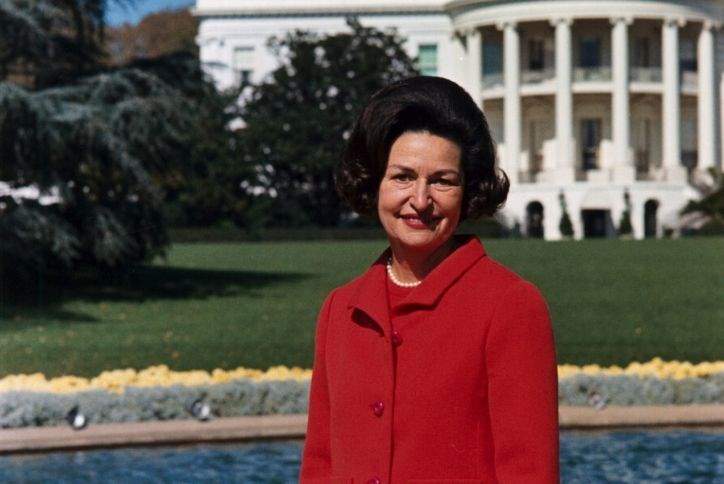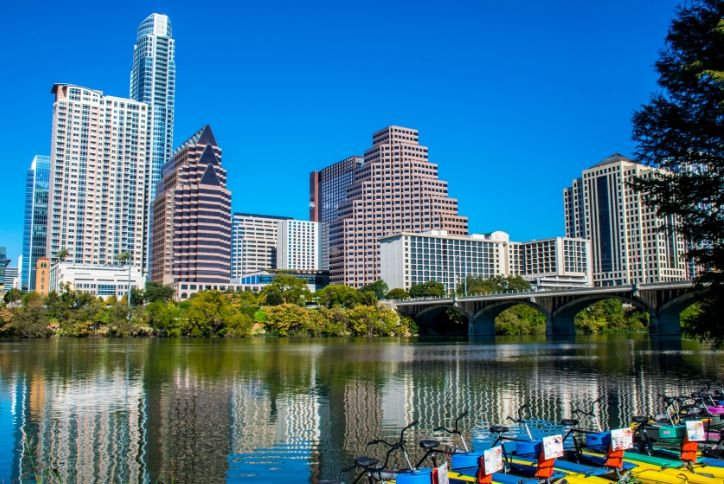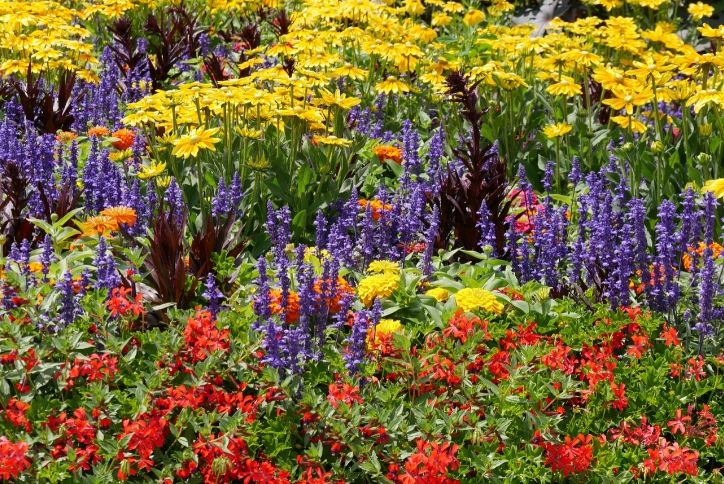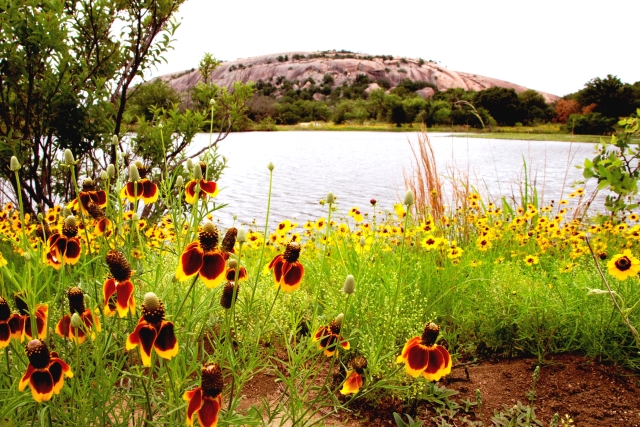
30 January . 2020
From lakes to wildflowers – how Lady Bird Johnson helped make Austin a natural city
Where flowers bloom, so does hope. — Lady Bird Johnson
The legacy of Lady Bird Johnson stretches from coast to coast across the United States, but nowhere is the impact of this groundbreaking former First Lady of the United States more visible than in Austin and the surrounding Hill Country, where she was personally responsible for creating or preserving three of our most treasured natural wonders.
During the administration of her husband, President Lyndon Baines Johnson, Mrs. Johnson played a direct role in 50 major initiatives related to conservation and beautification, from the Highway Beautification Act to the Wild and Scenic Rivers Program. After leaving political life, Mrs. Johnson continued to advocate for the environment, with so much passion that her name graces everything from the 300-acre Lady Bird Johnson Grove in California’s Redwood National Park, to the Lady Bird Johnson Memorial Cherry Blossom Grove in Missouri.
Much has been written about Lady Bird Johnson’s early life in East Texas and Alabama, and her political history as a First Lady who forged the modern role of that office as we know it. You can find an excellent summary here.
For this blog, we’ll focus on three major accomplishments by Mrs. Johnson that have had major impacts on Austin and the Hill Country, immeasurably improving our quality of life and helping to expand national and global awareness of the environment.
At Sweetwater, a community located where Austin meets the Hill Country – with a lifestyle that includes more than 700 acres devoted to parks, trails, recreational amenities and natural open spaces – we are excited to share the story of Mrs. Johnson’s natural legacy.
Lady Bird Lake


If Mrs. Johnson had her way, Lady Bird Lake would still be known as Town Lake, even though she was instrumental in transforming it from a weed-infested, litter-filled no man’s land into Austin’s most loved recreational area.
Always more interested in making a difference than gaining recognition, Mrs. Johnson had declined the honor of having Town Lake named after her several times during her lifetime. But shortly after her death in 2007, Austin City Council passed a resolution to change the name of the reservoir to recognize the former First Lady.
Town Lake was created by the City of Austin in 1960, when the Longhorn Dam was built to create this 416-acre impoundment along the Colorado River. In addition to its primary purpose a cooling pond for a new city power plant, which was decommissioned in 2007, Town Lake was envisioned as a recreational asset for the city, and a short trail was initially built. Within 10 years, the banks of the lake had become overgrown with weeds and strewn with litter, prompting a local TV station to call it an “eyesore.”
Mrs. Johnson’s efforts to improve Town Lake began in 1971, when she was inspired by the natural beauty she saw along the banks of the River Thames in London. Others had made attempts to turn Town Lake around before, but it was Mrs. Johnson who galvanized Mayor Roy Butler and his wife, Ann, to lead a campaign to beautify the lake. The city acted quickly to remove the trash, add trees and other plantings, and extend the existing small trail to 10 miles.
Mrs. Johnson had suggested that the trail be completed in time for Austin’s centennial celebration on July 4, 1976, as a celebratory gift to the nation, and it was. This trail was later named in honor of Mrs. Johnson’s partners in preservation, as the Ann and Roy Butler Hike-and-Bike Trail.
Although many Austinites still call Town Lake by its original name, Mrs. Johnson’s role in transforming this lake into the heart and soul of Austin is undeniable.
Today, Lady Bird Lake is the emerald necklace that knits together many of Austin’s most-used recreational areas and natural attractions, including Zilker Park, Barton Springs, the Congress Avenue Bat Colony, Deep Eddy Pool and Red Bud Isle. These areas host some of Austin’s most iconic festivals, such as the ACL Music Festival and Austin Reggae Festival.
The natural beauty and recreation offered by Lady Bird Lake and the six other Highland Lakes upstream along the Colorado River are one the primary reasons why U.S. News & World Report has named Austin as America's Best Place to Live for three consecutive years.
With a location that’s just 22 miles from downtown Austin, Sweetwater offers easy access to Lady Bird Lake. We’re even closer to Lake Travis, the longest of the Highland Lakes, winding for more than 60 miles through Austin and the Hill Country. Mrs. Johnson and her husband are also united forever in this chain of lakes, since one of them is named Lake LBJ.
Lady Bird Johnson Wildflower Center

Anyone who has ever worried about slowing down later in life should look to Mrs. Johnson for inspiration. In 1982, on her 70th birthday, she founded the National Wildflower Research Center along with actress Helen Hayes.
Mrs. Johnson donated funding and 60 acres of land in East Austin to establish the center, which proclaimed its mission as protecting and preserving North America’s native plants and natural landscapes.
The center became so popular with Austinites that it soon outgrew its original location. In 1995, it moved to its current location 10 miles south of downtown Austin, on a site that straddles a transition zone between the Edwards Plateau and the Texas Blackland Prairies ecoregions. The original 42-acre site was soon expanded to protect again encroaching development, and the center now covers 284 breathtaking acres.
In 1997, the center was renamed as the Lady Bird Johnson Wildflower Center, recognizing it as a signature piece of her environmental legacy.
In 2006, the Center became part of The University of Texas at Austin, complementing two other UT institutions named for the Johnson family: the Lyndon B. Johnson Presidential Library and the Lyndon B. Johnson School of Public Affairs. In 2017, the Center was officially designated as the Botanic Garden and Arboretum of Texas.
“Our Center works for more than the lovely blossoms in our open spaces. We are concerned for all of North America’s native plants, from the smallest sprout to the tallest tree,” Mrs. Johnson said.
Since its founding, the center has evolved from a private nonprofit research organization that was narrowly focused on Texas wildflowers, to a major botanic garden and research unit of the university. Today, it is known for plant conservation, landscape restoration and sustainable approaches to landscape design.
While it is one of Austin’s most popular natural attractions, drawing more than 200,000 guests each year, the Center has an impact that resounds far beyond the Hill Country. It is making a difference for the health of the planet through its research, demonstration projects, education programs, and the development of national-scale programs to promote sustainable landscapes.
For example, the Center has impacted more than 90,000 acres of landscapes, has collected more than 200,000 milkweed seeds to help protect the endangered Monarch butterfly, and has stockpiled seeds from eight species that are vulnerable to extinction. It is the founding developer of SITES, which has become the world’s most comprehensive rating system for sustainable land design and development. Its patented SkySystem is a planting medium used to create green roofs in hot climates, made from 100 percent recycled content.
One of the Center’s most popular attractions is the Luci and Ian Family Garden, named for one of the Johnsons’ daughters and her husband. This 4.5-acre garden connects children and families to the natural world with more than a dozen interactive and educational features, all made of natural materials. These include giant tree stumps to climb on and around, a walk-through Fibonacci spiral, a grotto with caves and a picturesque waterfall, a math-themed hopscotch, and much more.
Throughout the Center, visitors will enjoy seeing nearly 900 species of Texas native plants, nine acres of cultivated gardens, the 16-acre Texas Arboretum with more 70 species of native Texas trees, and 148 species of birds.
At Sweetwater, we enjoy our own special connection to the Lady Bird Johnson Wildflower Center. During the early years of creating Sweetwater’s master plan, they worked with us to seed the beautiful native wildflowers that bloom each spring throughout our community.
Enchanted Rock

Lady Bird Lake and the Wildflower Center are well-known pieces of Mrs. Johnson’s substantial environmental legacy in the Austin area. But many people aren’t aware of the important role she played in rescuing one of the most iconic natural landmarks in the Hill Country, and in fact all of Texas: Enchanted Rock.
In the late 1970s, the owners of this legendary granite dome, which rises 425 feet above Big Sandy Creek near Fredericksburg, had put it up for sale. Proposals for developing it included turning it into a granite quarry, creating an amusement park, and carving it into a Texas version of Mount Rushmore.
In 1977, Mrs. Johnson made an emergency phone call to Patrick Noonan, who was at the time the president of The Nature Conservancy, widely regarded as one of the most effective environmental organizations in the world.
“Pat, you must come quickly,” she told him, recounting her fear that Enchanted Rock would be developed and destroyed, as had many other similar domes around Gillespie and Llano counties. These mammoth rock outcroppings had already been heavily quarried for granite that had been used to build everything from the Texas State Capitol to the Galveston Seawall.
Two days after Mrs. Johnson’s first call, Noonan journeyed from the Conservancy’s headquarters in the Washington, D.C. area and climbed to the top of Enchanted Rock with her. Later, over dinner at nearby LBJ Ranch, they discussed ways to save this unique natural landmark for posterity.
“We’re not going to lose this wonderful piece of Texas heritage, and you’re going to help me,” Mrs. Johnson said to Noonan.
Based on Mrs. Johnson’s endorsement and strong support, the Conservancy purchased the property for $1.3 million and deeded the land to the state of Texas.
In 1978, Enchanted Rock opened as an official State Natural Area. It has been designated as a National Natural Landmark and is also on the National Register of Historic Places as an Archaeological District.
Today, more than 250,000 people come to the park to experience the wonder of Enchanted Rock, making it one of the most visited parks in the state system.
This rock is actually a “batholith,” a geologic phenomenon of monumental proportions, created when molten magma cools and crystalizes into granite, under layers of rock far below the surface of the earth.
Enchanted Rock emerged from underground over millions of years, gradually exposed by uplifting, erosion, and the ebb and flow of seas that once covered this part of Texas. The domelike shape of Enchanted Rock evolved through a process known as “exfoliation,” where natural heating and cooling processes cause the granite to flake off in thin, curving layers.
Perhaps the most popular activity is to hike Summit Trail, which leads up to the top of Enchanted Rock. Though only six-tenths of a mile long, it climbs 425 feet. The area has nine miles of trails in all, including the gentler four-mile Loop Trail, which meanders past Moss Lake and the rock’s base.
Enchanted Rock takes its name from the awe it inspired among the Tonkawa Indians in the early 1800s. They considered the dome to be enchanted by spirits, whose presence was revealed by the sounds of creaking and groaning, which were actually caused by the natural heating and cooling of the rock.
The Tonkawas believed that these spirits could cast spells on intruders, and legend has it that a captive Spanish conquistador was swallowed by the rock and joined the resident spirits for eternity.
Sweetwater is about 75 miles from Enchanted Rock, making for an easy day trip or weekend getaway that can also include the charms of historic Fredericksburg and other nearby attractions such as wineries. It’s an especially popular trip to enjoy during the spring wildflower season.
Learn more about natural attractions surrounding Sweetwater with our Hill Country Recreation Guide.
Lady Bird Johnson photo by Robert Knudsen, used with permission from LBJ Library.